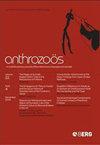Exploring Animal Abuse Proclivity, Everyday Sadism, and Attitudes Toward Animals in Cyprus
IF 2.3
2区 农林科学
Q2 SOCIOLOGY
引用次数: 0
Abstract
ABSTRACTThis study examined the relationships between animal abuse proclivity, everyday sadism, and attitudes toward animals in Cyprus. Past research found relationships between animal abuse proclivity and attitudes toward animals, and animal abuse proclivity and sadism, but much of this research is still in its early stages. There is currently no research incorporating these three constructs into one analysis. The aim of the present study, therefore, was to further explore these relationships and determine links between constructs that had not been previously studied together. For the study, 263 people were recruited from the general population of Cyprus. Participants were requested to provide demographic details and fill in the Animal Abuse Proclivity Scale, the Short Sadistic Impulse Scale, and the Attitudes Toward the Treatment of Animals Scale. Data were collected online with Greek and English versions of the questionnaires being made available. The data were subsequently merged, and path analyses were conducted to investigate the relationships. Animal abuse proclivity, specifically the Thrill subscale, was predicted by greater everyday sadism, less positive attitudes toward animals, and being female. The animal abuse proclivity Power subscale was predicted by less positive attitudes toward animals. More positive attitudes toward animals were predicted by being female and older, but attitudes toward animals were not predicted by either of the two key constructs. Finally, greater everyday sadism was predicted by less positive attitudes toward animals, younger age, and being male. Demographic differences were also identified in the analysis. The discussion highlights the significance of supporting the findings of previous studies and tentatively identifies new relationships worthy of future examination.KEYWORDS: Animal abuse proclivityattitudes toward animalsCypruseveryday sadismexploratory researchhuman–animal interaction Disclosure StatementNo potential conflict of interest was reported by the author.探索动物虐待倾向,日常虐待,和态度对待动物在塞浦路斯
摘要本研究探讨了塞浦路斯动物虐待倾向、日常虐待和对待动物态度之间的关系。过去的研究发现了虐待动物倾向和对待动物的态度之间的关系,以及虐待动物倾向和虐待狂之间的关系,但大部分研究仍处于早期阶段。目前还没有研究将这三种结构合并到一个分析中。因此,本研究的目的是进一步探索这些关系,并确定以前没有一起研究过的构念之间的联系。在这项研究中,263人从塞浦路斯的一般人口中被招募。参与者被要求提供详细的人口统计资料,并填写动物虐待倾向量表、短暂虐待冲动量表和对待动物态度量表。数据在网上收集,并提供了希腊语和英语版本的调查问卷。随后对数据进行合并,并进行通径分析以调查其关系。动物虐待倾向,特别是刺激子量表,与日常虐待倾向、对动物的不积极态度和女性有关。虐待动物倾向力分量表可以通过对动物不太积极的态度来预测。女性和年龄越大,对动物的态度越积极,但这两个关键构念都无法预测对动物的态度。最后,对动物的态度不积极、年龄较小和为男性预示着更大的日常虐待狂。在分析中也发现了人口统计学上的差异。讨论强调了支持先前研究结果的重要性,并初步确定了值得未来研究的新关系。关键词:虐待动物倾向;对待动物的态度;日常虐待;探索性研究;
本文章由计算机程序翻译,如有差异,请以英文原文为准。
求助全文
约1分钟内获得全文
求助全文
来源期刊

Anthrozoos
农林科学-兽医学
CiteScore
3.40
自引率
18.80%
发文量
43
审稿时长
>36 weeks
期刊介绍:
A vital forum for academic dialogue on human-animal relations, Anthrozoös is a quarterly, peer-reviewed journal that has enjoyed a distinguished history as a pioneer in the field since its launch in 1987. The key premise of Anthrozoös is to address the characteristics and consequences of interactions and relationships between people and non-human animals across areas as varied as anthropology, ethology, medicine, psychology, veterinary medicine and zoology. Articles therefore cover the full range of human–animal relations, from their treatment in the arts and humanities, through to behavioral, biological, social and health sciences.
 求助内容:
求助内容: 应助结果提醒方式:
应助结果提醒方式:


